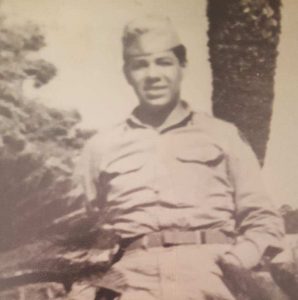Romo, Angel Peter
Army Private
Angel Peter Romo from California, Los Angeles county.
Service era: Korea
Date of death: Wednesday, November 8, 1950
 Death details: On July 11, 1950, the U.S. Army’s 21st Infantry Regiment, which had arrived in Korea six days earlier, was placed in defensive positions near the town of Chochiwon, South Korea. The regiment was not at full strength and lacked artillery and anti-tank weapons. That day, they were attacked by North Korean forces and were forced to withdraw to avoid being surrounded, as well as to buy time until they could be reinforced and resupplied. Private First Class Angel Pete Romo, who joined the U.S. Army from California, served with I Company, 3rd Battalion, 21st Infantry Regiment, 24th Infantry Division. He was captured by enemy forces on July 11, as his unit fought a series of delaying actions between Pyongtaek and Chochiwon. He was forced to march to the Apex prison camps in North Korea, but he was suffering from exhaustion and pneumonia and was eventually unable to walk without assistance. On November 8, a guard ordered PFC Romo’s companions to stop helping him, and he collapsed on the side of the road. His companions were forced to move on without him. They later stated that they believed PFC Romo was shot by the guard. His remains have not been identified among those returned to U.S. custody. Today, Private First Class Romo is memorialized on the Courts of the Missing at the National Memorial Cemetery of the Pacific.
Death details: On July 11, 1950, the U.S. Army’s 21st Infantry Regiment, which had arrived in Korea six days earlier, was placed in defensive positions near the town of Chochiwon, South Korea. The regiment was not at full strength and lacked artillery and anti-tank weapons. That day, they were attacked by North Korean forces and were forced to withdraw to avoid being surrounded, as well as to buy time until they could be reinforced and resupplied. Private First Class Angel Pete Romo, who joined the U.S. Army from California, served with I Company, 3rd Battalion, 21st Infantry Regiment, 24th Infantry Division. He was captured by enemy forces on July 11, as his unit fought a series of delaying actions between Pyongtaek and Chochiwon. He was forced to march to the Apex prison camps in North Korea, but he was suffering from exhaustion and pneumonia and was eventually unable to walk without assistance. On November 8, a guard ordered PFC Romo’s companions to stop helping him, and he collapsed on the side of the road. His companions were forced to move on without him. They later stated that they believed PFC Romo was shot by the guard. His remains have not been identified among those returned to U.S. custody. Today, Private First Class Romo is memorialized on the Courts of the Missing at the National Memorial Cemetery of the Pacific.
Source: National Archives, Defense POW/MIA Accounting Agency